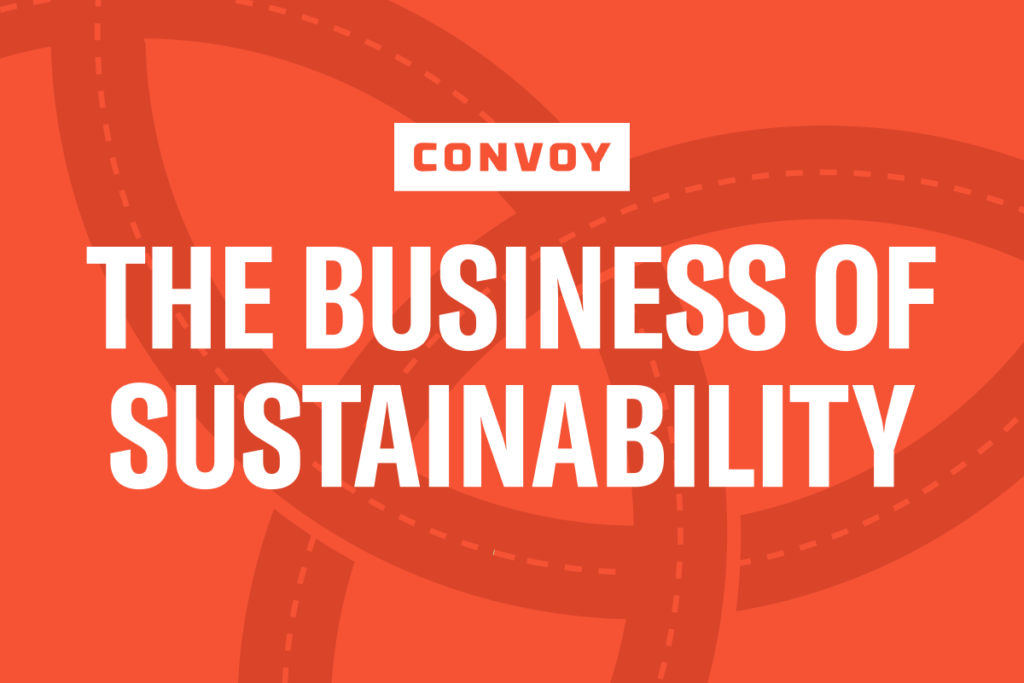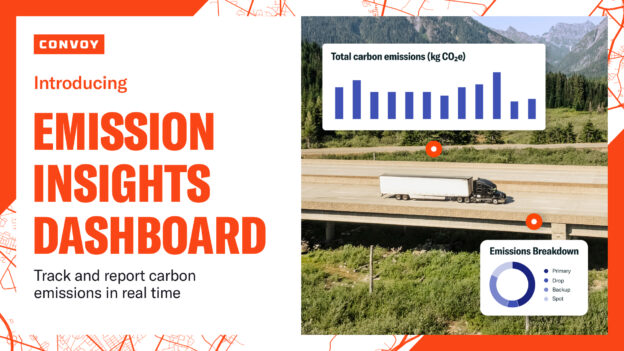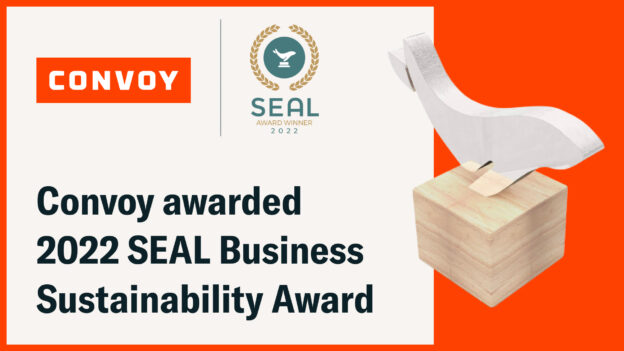The Payoffs Of Being A Sustainable Organization
Sustainability • Published on March 15, 2021
The sustainability conversation occurs much more frequently in boardrooms these days; however, more often than not, the focus is on how much a company needs to invest to do the right thing versus what the payoffs will be in both the short and long term.
In looking back at our Business of Sustainability interview series, we gathered some significant insights from sustainability leaders around the country about the intended and unintended payoffs of being a sustainable organization. All have found the original intention for incorporating sustainability into their company’s business practices had positive consequences which were not always originally identified.

1. Being sustainable is actually good for business. Harshad Kanvinde, Practice lead – Strategy & Supply Chain, Slalom Consulting, notes “It’s not an either or conversation. It’s not that we need to deliver on the cost and also need to do good things for earth and for people. Being sustainable helps me deliver the best cost. Being sustainable, also helps me build a resilient supply chain that’s not dependent on one region, one supplier, and so on.”
2. A social purpose can drive a business benefit. Tyson Foods’ Senior Director, Corporate Social Responsibility, Debra Vernon reports, “The overall return on investment of our social impact program called Upward Academy was about 123%. For every dollar we invest, we get 1.23 back. The baseline seems to be increasing job satisfaction and loyalty and a lot of our team members participate. We found that the expected rate of termination for our company was usually about 31% for various reasons (equating to about 162 terminations). If the team member was enrolled in Upward Academy, the turnover rate was reduced to 3.3% or 17 terminations. So, we saved about 145 terminations and each of those turns is $6,000 dollars for us so that was the business upside for us.
3. Sustainability drives innovative thinking. Danielle Jezienicki, Director of Sustainability, at Grove Collaborative notices that sustainability drives innovation. “Our paper products are a really good example of this. When you see brands in the store like Charmin, those brands are made with virgin paper which directly contributes to deforestation. Why would we cut down a valuable forest and literally flush it down the toilet? The way Grove Collaborative thinks about paper is to use a regenerative resource to make it out of bamboo. It is shipped without any plastic at all in the packaging, and, bigger picture, instead of contributing to deforestation, we have a goal to plant a million trees through Arbor Day so every purchase supports that goal to plant a million trees. Being sustainable forces you to rethink a category and consider opportunity for regeneration versus the negative impacts we unfortunately make as an industry.
4. Zero cost investments can make a difference. Julie Verdugo, Director of Sustainability + Social Impact at Free People knows that you don’t need to make a large investment in new technology, etc. to be sustainable. “A lot of companies actually have a lot of zero cost opportunities or even cost savings in some instances. Look at operations in a new way. Energy reduction programs are actually cost savings. Start with a task force as a side project with someone representing each function and get creative to identify cost savings and net zero initiatives because there is a lot of impact behind those too.”
5. Sustainability efforts can reach beyond specific product development and raw materials. Katherine Pickus, Vice President of Global Sustainability at Griffith Foods has recognized that “the sustainability aspect trends toward not just how does the company ensure the highest quality of ingredients, but how can our efforts also improve the farmers’ livelihoods and empower them to engage.”
6. Sustainability goals often expand throughout the company beyond what your initial plans entailed. Christine Riley Miller, Global Director of Sustainability at Samsonite has found a common conversation amongst departments and employees centers around how to be more sustainable. “There will be many people who are really interested in how they can contribute to the sustainability of the organization and how they can contribute to progress against your defined goals. With Samsonite, our product designers are constantly sharing innovative ideas around how we increase the durability and repairability of our products. In the retail environment, our store designers will make the decision to utilize all LED lighting.”
7. Employees have a greater sense of pride in their work. Amy Blyth, Director, Program Development and Partnerships at Fair Trade USA reports that “Workers at ‘fair trade’ certified organizations are happy and healthy, product quality is up, productivity is up, and there are intrinsic benefits which companies get from investing in fair trade that you don’t see on a bottom line, but really do build brand value and quality products.”
8. You have an opportunity to reinvent your product. Tiila Abbitt, Founder & CEO of Aether Beauty, feels that looking at your business as a more sustainable organization opens the door for reinvention. “Do your customers really want everything you include in your product and packaging? We learned, for example, makeup artists didn’t want mirrors and magnetic closures in makeup palettes because it made them much heavier to carry around. From a sustainability perspective, the ingredients used to create a magnet contribute to rare Earth mining which means terrible human conditions to mine those ingredients and they ultimately do not break down in a landfill.”
9. You can empower those in your supply chain to think greener: Mia Davis, Director of Environmental and Social Responsibility at Credo Beauty views sustainability as not just positively affecting your company, but all of those in your supply chain. “It is one thing when you make your own products and have a lot more control over your ingredients, but when you are working with other brands, there is a way to educate and empower those in your supply chain to ask those difficult questions about the ingredients they are using.”
10. You don’t always have to add new initiatives to your operations — sometimes monitoring what you already do can make a big difference: Danika Padilla, the Director of Social Impact at Meow Wolf, has made her company’s top priorities monitoring water, waste, and energy use at their facilities and then setting up those same measurement mechanisms for new facilities going forward. “We are also incorporating green building designs into our new locations and incorporating green features into the buildings, using 100% LED lighting, low flow toilets and faucets, etc. We are looking at setting those standards now so they can go into every single building and we then have a blueprint for the future as we grow. It can be as simplistic as this in working across different teams and assessing and understanding the areas where you can make impactful changes.”
11. Being a sustainably minded company can make it easier to secure financing and contracts: Mary Tullis Engvall, Senior Director of Corporate Responsibility at Cigna, views the work Black Rock has done by changing from a philosophical approach to assessing companies by using ESG as a proxy for good management as an important shift in the financial industry. “What the investor community is doing right now is making all of this very real for companies. Our clients are asking us everyday in every freight RFP about these issues, because they want to do business with companies that are like-minded.”
12. It creates more cohesion throughout a business: Thomas Heckroth, Director of Strategic & Responsible Sourcing at Stitch Fix knows sustainability permeates throughout a company. “It’s not necessarily because we required it to be that way, but the people who work at Stitch Fix are interested and committed to making sure we are a more sustainable company. Each team, whether it’s the packaging team or the operations team or the product development team, all have pieces of sustainability they are thinking about on a day-to-day basis. They know what they want to do and what the goals are in trying to get us to be more sustainable. We do have an opportunity to make the company more streamlined — to make sure we are all rowing the boat in the same direction and not doubling up on efforts.”
13. Sustainable businesses can access lower cost capital: Yalmaz Siddiqui, Vice President of Corporate Sustainability at MGM Resorts International reports In the last two years, there has been a seismic shift involving investors. “Environmental social governance (ESG) investment flows forecast to be at 50% of all investments in 2025. Investors who want to acquire, invest in your company, or take equity positions are going to want to know what you’re doing regarding environmental social governance practices. If you want investment capital, if you want to lower the cost of capital ultimately, then you need to be focused on these things. ESG efforts will legitimize a lot more expenditure, a lot more strategy, and a lot more hiring because it’s going to enable capital.”
14. A company can operate more efficiently overall: Wylie Robinson, Founder and CEO at Rumpl, believes a sustainability lens really forces you to identify and manage inefficiencies. “We really try as hard as possible to not do any air freight of our products because it’s expensive and we have to offset the carbon at the end of the year. It is way more efficient for us to get our purchase orders in on time, make sure we have the right inventory, and send all that product through to our warehouse on a slow boat. It costs less and it emits less carbon. The goal is really more of an operational goal and it just happens to be integrated with our sustainability committee ethics.”
15. You learn to better assess risks for your organization: Jane Franch, Director, Strategic Sourcing & Sustainability at Numi Organic Tea believes all businesses need to be asking themselves “What risks do climate change bring to my business and what am I not accounting for here?” She adds, “We’ve had the luxury and the ability to not look at it straight in the eye for far too long and we are getting to the point now where it is no longer a luxury any business can afford. We can no longer ignore what is happening with the climate. On the supply side, it is deeply affecting our distribution network. Anybody who is not seeing this right now is not asking the right questions. As soon as we can ask ourselves those questions and connect the dots and really look at what this means for my business moving forward, then I think we can start to identify some of those priorities and determine where we might want to take action.”
16. You look at everything through a different lens — including customer and employee mobility: Angela Hultberg, Head of Sustainable Mobility at IKEA has found that mobility is really a prerequisite for everything they do. “Last mile deliveries are a very visible example because we send more and more delivery vehicles into city centers and that comes with impact. Mobility is also super important to our people and culture department because transport is the second biggest cost for most households including our co-workers. A lot of our co-workers are young. They don’t own cars. So how will they even get to Ikea because our workplaces are usually not in the city center. This becomes a problem for us to attract talent. And if we want customers to come to our stores, we need to help them get there in a sustainable, affordable, and convenient way. All companies are in the same situation — even though these considerations are so frequently overlooked. If you are not attractive to talent on the market because it is simply too costly, it takes too long, or it’s too inconvenient to get to work, talent will choose another company. It would not be the most effective way to operate if the commute was the reason you can’t attract talent.”
17. Sustainable brands have premium market value: Gretchen Grani, Regeneration & Sustainability Lead at Guayaki Yerba Mate co has seen a lot of evidence that sustainable brands have a premium market value. “This is being driven by consumers who want to make an impact with their purchases and look for mission-driven companies. Sustainability value also extends beyond consumers to all the stakeholders. Social impact investors look to make an impact through their investments. Employees want to work with a company they believe in. Producers are receiving fair-trade, enhanced value in their land. The value of sustainability to the world is leveling the playing field.”
18. You attract customers who prefer to do business with sustainable brands: Nira Johri, Director of Global Diversity and Sustainability at Rich Products Corporation has seen that “Customers are prioritizing sustainability, so we understand where our sustainability demand comes from. Over 60% of our US and Canadian customers have prioritized sustainability in their future plans, so that means it has to be a priority for us as one of their important suppliers.”
19. It gives you an opportunity to better engage customers: Jeff Smith, Vice President of Sustainability at Six Senses shares that “Part of our aim is to capture our guests’ interests and that’s actually a great opportunity when they are on vacation with their minds relaxed and open to new ideas. They ask ‘what are you doing with your glass bottles back there?’, and we actually do workshops around this so we invite them to come and learn what we do with our glass bottles. For example at one property we crush our bottles and make new things. We do upcycling at our resorts and we like to involve guests in that. Some guests arrive not knowing what we do, but ideally every guest leaves at least being aware of what we’re doing to ensure that their stay has been the lowest impact possible, the lowest negative impact but also a positive impact on our community’s environment. We are in an industry of providing experiences, so we try to draw it all together and hopefully we’ve equipped our guests with some tips they can take back home or we have inspired them to live a slightly more sustainable lifestyle when they go on with their lives back home. That is part of our mission as well.”
20. Embracing sustainability puts companies in a better position — even during COVID: Kelly Fisher, SVP/Head of Corporate Sustainability at HSBC admits “The real turning point for me was last year because 2020 was awful for everyone and I think some of us in the field were very afraid we would see it be a year where people said, ‘let’s set aside this green agenda for a while because this is going to be a year of crisis,’ and we actually saw the opposite. HSBC, for example, was the first to the market early in the spring with research that showed ESG stocks were outperforming other stocks in the market volatility which happened in April. That was incredible. And that’s what investors are always nervous about. ‘Well, wait, of course I want to invest in companies that have better ESG performance, but I also want a return.’ And then we were the first to market with a COVID bond in Asia and we saw a lot of our clients stepping forward and saying, ‘You know, what you’re doing with this on green, we want to do that with some social, some sustainable finance products that would support our social activities.’ So, the fact that instead of people sitting to the side last year and saying, ‘I’ll get back to that later,’ they’re actually doubling down on the activities they’re doing around ESG and sustainable finance.”
21. It lets you see opportunities you might not have noticed before: John Sadlier, Chief Sustainability Officer at Ardagh Group, believes it gives you a new lens to view your business. “Looking at it more offensively, it’s an opportunity. We’ve got super materials and the more sustainable we can make those materials, the more value we can give society with those materials. So, I do look at it both ways. The optimist in me would look more toward the offensive side — we’ve got these wonderful materials — how can we put more and more products into these materials because they’re sustainable and, ultimately, add greater value to society?”
22. Customers want to be a part of your sustainability journey: Bryan Pape, CEO of Miir realized people want to be a part of something great. “We began our product to project concept upon returning from one of our first nonprofit partnerships in Liberia. We had photos and stories and shared them with our first customers. One of my friends, who was our first customer, said, ‘Wow, that’s incredible. This Miir bottle that I bought helped fund that clean water project.’ And that’s when a huge lightbulb went off and we started this thing called the ‘Give Code,’ where customers can look on the bottom of their tumbler or their Miir bottle, reference the code there, and register this give code on our website to get updates on the exclusive benefits we are working on for that community. It is all about transparency for us. Inviting our customers to come along on the journey is incredibly important. Our goal is to be a bridge between the individual consumer as well as the nonprofit partner as well.
23. Sustainability can truly show up across an organization: Zach Freeze, the Senior Director, Strategic Initiatives, Sustainability at Walmart, affirms “It is something we’re trying to embed within every role at Walmart. We want everyone to feel a part of this goal because it’s going to take all of us to really be able to deliver this ambitious commitment. We really want to engage with every area of the company to instill ownership of the goals and the work that needs to happen. Every part of our company needs to get involved including getting to zero waste in operations, ensuring we’re on our emissions reduction track, and procuring more renewable energy. Even on the buying side, getting buyers engaged, thinking about the product life cycle and the supply chain it takes to put that product on our shelf.”



